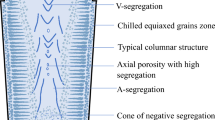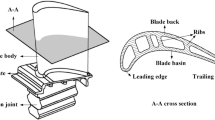Abstract
The goal of the present study is to predict the formation of solidification induced defects in castings by thermal criteria functions. In a criterion function method, the heat transfer equation is firstly solved, and then the susceptibility of defect formation at every point in the casting is predicted by computing a local function, criterion function, using results of the thermal analysis. In the first part of the paper, some famous criteria functions, in particular, the Pellini and Niyama criteria, are analyzed and their shortcomings are discussed in details. Then, a new criterion function is suggested to decrease the shape-dependency issue of the former criteria. The feasibility of the new method is studied by comparing numerical results against some archived experimental data.
Similar content being viewed by others
References
Campbell J. (2003) Castings. Butterworth-Heinemann
Niyama E., Uchida T., Morikawa M., Saito S. (1982) A method of shrinkage prediction and its application to steel casting practice. AFS Int. Cast Metals J. 7:52–63
Carlson K. D., Hardin R. A., Ou S., Beckermann C. (2002) Development of new feeding-distance rules using casting simulation: part I. Methodology. Metall. Mater. Trans. B 33:731–740
Stefanescu D. (2005) Computer simulation of shrinkage related defects in metal castings—a review. Int. J. Cast Metals Res. 18:129–143
Tavakoli R., Davami P. (2007) Unconditionally stable fully explicit finite difference solution of solidification problems. Metall. Mater. Trans. B 38:121–142
Hong C.P. (2004) Computer modelling of heat and fluid flow in materials processing. CRC Press
Lewis R.W., Ravindran K. (2000) Finite element simulation of metal casting. Int. J. Numer. Meth. Eng. 47:29–59
Pao W.K.S., Ransing R.S., Lewis R.W., Lin C. (2004) A medial-axes-based interpolation method for solidification simulation. Finite Elem. Anal. Des. 40 (5):577–593
Pequet C., Gremaud M., Rappaz M. (2002) Modeling of microporosity, macroporosity, and pipe-shrinkage formation during the solidification of alloys using a mushy-zone refinement method: applications to aluminum alloys. Metall. Mater. Trans. A 33:2095–2106
Pellini W. (1953) Factors which determine riser adequacy and feeding range. AFS Trans. 61:61–80
Ou S., Carlson K.D., Hardin R. (2002) Development of new feeding-distance rules using casting simulation: part II. the new rules. Metall. Mater. Trans. B 33:741–755
Ou S., Carlson K.D., Beckermann C. (2005) Feeding and risering of high-alloy steel castings. Metall. Mater. Trans. B 36:97–116
Carlson K.D., Qu S., Beckermann C. (2005) Feeding of high-nickel alloy castings. Metall. Mater. Trans. B 36:843–856
Hansen P., Sahm P. (1988) How to model and simulate the feeding process in casting to predict shrinkage and porosity formation. In: Modeling of casting and welding process IV, pp. 33–42. TMS-AIME
Hansen P., Sahm P., Flender E. (1993) How to select and use criterion functions in solidification simulation. AFS Trans. 101:443–446
Sigworth G., Wang C. (1993) Mechanisms of porosity formation during solidification. A theoretical analysis. Metall. Mater. Trans. B 24:349–364
Spittle J., Almeshhedani M., Brown S. (1994) The Niyama function and its proposed application to microporosity prediction. Cast Met. 7:51–51
Carlson K., Beckermann C. (2009) Prediction of shrinkage pore volume fraction using a dimensionless Niyama criterion. Metall. Trans. A 40:163–175
Sigworth G. (2009) Discussion of prediction of shrinkage pore volume fraction using a dimensionless Niyama criterion. Metall. Trans. A 40:3051–53
Carlson K., Beckermann C. (2009) Authors reply to discussion of prediction of shrinkage pore volume fraction using a dimensionless Niyama criterion. Metall. Mater. Trans. A 40:3054–3055
Jakumeit J., Jana S., Böttger B., Laqua R., Jouani M.Y., Bührig-Polaczek A. (2012) Simulation-based prediction of micro-shrinkage porosity in aluminum casting: fully-coupled numerical calculation vs. criteria functions IOP conference series: materials science and engineering, vol 27. IOP Publishing, p 012066
Kang M., Gao H., Wang J., Ling L., Sun B. (2013) Prediction of microporosity in complex thin-wall castings with the dimensionless Niyama criterion. Mater. 6 (5):1789–1802
Lee Y.W., Chang E., Chieu C.F. (1990) Modeling of feeding behaviour of solidifying AI-7Si-0.3Mg alloy plate castings. Metall. Mater. Trans. B 21:715–722
Lee P.D., Chirazi A., See D. (2001) Modeling microporosity in aluminum–silicon alloys: a review. J. Light Met. 1:15– 30
Felicelli S.D., Wang L., Pita C.M., De Obaldia E.E. (2009) A model for gas microporosity in aluminum and magnesium alloys. Met. Mater. Trans. B 40 (2):169–181
Tavakoli R., Davami P. (2008) Optimal riser design in sand casting process by topology optimization with SIMP method I: poisson approximation of nonlinear heat transfer equation. Struct. Multidisc. Optim. 36:193–202
Tagavi K., Chow L., Solaiappan O. (1990) Void formation in unidirectional solidification. Exp. Heat Transf. 3:239–255
Sulfredge C, Chow L, Tagavi K (1993) Void initiation and growth in unidirectional freezing. Exp. Heat Transf. 6:411– 436
Kim J.M., Kim D.G., Kwon H.W., Loper C.R. (1998) Pore behavior at the solid/liquid interface during solidification. Scripta Mater. 39:969–975
Flemings M.C (1974) Solidification processing. McGraw-Hill
Santos R., Garcia A. (1998) Thermal behaviour during the inward solidification of cylinders and spheres and correlation with structural effects. Int. J. Cast Met. Res. 11:187–195
Osher S., Fedkiw R. (2003) Level set methods and dynamic implicit surfaces, volume 153 of applied mathematical sciences. Springer
George E.S., Elder S.P., Abbaschian G.J. (1988) Thermal profiles measured during casting of a steel hammer. In: modeling of casting welding and adevanced solidification processes IV, pp. 775–788. TMS-AIME
Morthland T.E., Byrne P.E., Tortorelli D.A., Dantzig J.A. (1995) Optimal riser design for metal castings. Metall. Mater. Trans. B 26:871–885
Manzari M.T., Gethin D.T., Lewis R.W. (2000) Optimisation of heat transfer between casting and mould. Int. J. Cast Metals Res. 13:199–206
Ransing R.S., Pao W.K.S., Lin C., Sood M.P., Lewis R.W. (2005) Enhanced medial axis interpolation algorithm and its application to hotspot prediction in a mouldcasting assembly. Int. J. Cast Metals Res. 18(1):1–12
Author information
Authors and Affiliations
Corresponding author
Rights and permissions
About this article
Cite this article
Tavakoli, R. On the prediction of shrinkage defects by thermal criterion functions. Int J Adv Manuf Technol 74, 569–579 (2014). https://doi.org/10.1007/s00170-014-5995-0
Received:
Accepted:
Published:
Issue Date:
DOI: https://doi.org/10.1007/s00170-014-5995-0




